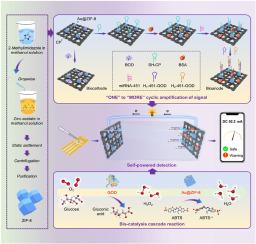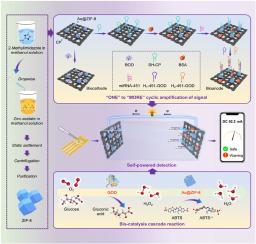级联催化策略辅助下的目标驱动型自供电传感器的先进设计
IF 5.7
2区 化学
Q1 CHEMISTRY, ANALYTICAL
引用次数: 0
摘要
本研究开发了一种基于酶生物燃料电池(EBFCs)的自供电微传感器平台,用于智能监测疾病标志物miRNA-451。利用类酶 ZIF-8 纳米胶囊与生物酶结合的策略构建的级联催化系统,兼顾了生物酶的特异性和纳米酶的高活性,显著促进了葡萄糖与生物阳极表面的电子传递,提高了传感系统的灵敏度和稳定性。同时,采用目标触发杂交链反应(HCR)放大策略,在准确识别的基础上实现指数级信号放大,共同提高了检测灵敏度。正如预期的那样,微传感器平台的线性范围宽达 0.5-1.0 fmol/L,检出限(LOD)低至 0.13 fmol/L(S/N=3),并在最佳检测条件下的干扰检测中表现出优异的选择性、重现性和稳定性。所设计的自供电系统构造简单、运输方便,数据传输模式智能可控,有望用于基础生化研究、临床诊断和环境监测。本文章由计算机程序翻译,如有差异,请以英文原文为准。


Advanced design of target-driven self-powered sensor assisted by cascade catalytic strategy
In this work, a self-powered microsensor platform based on enzyme biofuel cells (EBFCs) was developed for intelligent monitoring of disease markers miRNA-451. The cascade catalysis system constructed by using the strategy of enzyme-like ZIF-8 nanocapsule incorporation with biological enzymes, which could simultaneously take into account the specificity of biological enzymes and the high activity of nano-enzymes, significantly promoted the electron transfer between glucose and the bio-anode surface, and improved the sensitivity and stability of the sensing system. Meanwhile, the target-triggered hybridization chain reaction (HCR) amplification strategy to achieve exponential signal amplification based on accurate recognition, and jointly improve the detection sensitivity. As expected, the micro-sensor platform has a wide linear range of 0.5–1.0 fmol/L with a low limit of detection (LOD) of 0.13 fmol/L (S/N = 3) and exhibits excellent selectivity, reproducibility and stability in interference assays under optimal detection conditions. The designed self-powered system is simple to construct, easy to transport and the data transmission mode is intelligent and controllable, which is expected to be used in basic biochemical research, clinical diagnosis and environmental monitoring.
求助全文
通过发布文献求助,成功后即可免费获取论文全文。
去求助
来源期刊

Analytica Chimica Acta
化学-分析化学
CiteScore
10.40
自引率
6.50%
发文量
1081
审稿时长
38 days
期刊介绍:
Analytica Chimica Acta has an open access mirror journal Analytica Chimica Acta: X, sharing the same aims and scope, editorial team, submission system and rigorous peer review.
Analytica Chimica Acta provides a forum for the rapid publication of original research, and critical, comprehensive reviews dealing with all aspects of fundamental and applied modern analytical chemistry. The journal welcomes the submission of research papers which report studies concerning the development of new and significant analytical methodologies. In determining the suitability of submitted articles for publication, particular scrutiny will be placed on the degree of novelty and impact of the research and the extent to which it adds to the existing body of knowledge in analytical chemistry.
 求助内容:
求助内容: 应助结果提醒方式:
应助结果提醒方式:


